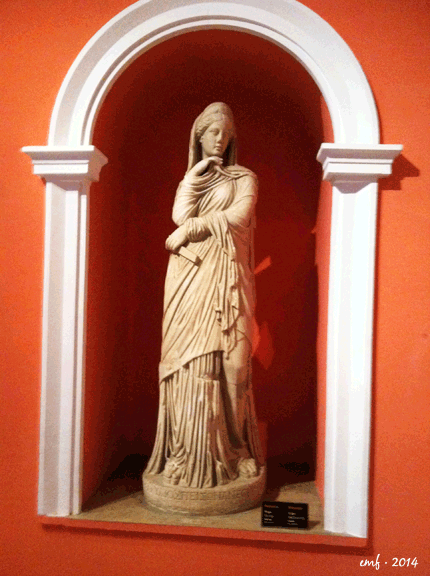Through Hadrian’s Gate
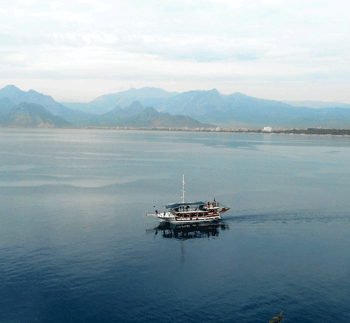 One of the hubs of the Turkish Riviera, Antalya has had a turbulent history since its founding in 150 BCE by the king of Pergamon. The city prospered as part of the Roman Republic, was visited by early Christian missionaries as recorded in the Acts of the Apostles, was a major city in the Byzantine Empire, the capital of the Turkish beylik of Teke in the fourteenth century, had a brief period of Cypriot rule, and was occupied by the Italians from the end of the First World War until the founding of the Turkish Republic in 1923. Now it is a major hub of Turkish tourism, ranked behind only Paris and London in number of international arrival visits. Fortunately for us, most visitors are on “all-inclusive” vacation packages and shuttled directly to the huge resorts lining the coastline.
One of the hubs of the Turkish Riviera, Antalya has had a turbulent history since its founding in 150 BCE by the king of Pergamon. The city prospered as part of the Roman Republic, was visited by early Christian missionaries as recorded in the Acts of the Apostles, was a major city in the Byzantine Empire, the capital of the Turkish beylik of Teke in the fourteenth century, had a brief period of Cypriot rule, and was occupied by the Italians from the end of the First World War until the founding of the Turkish Republic in 1923. Now it is a major hub of Turkish tourism, ranked behind only Paris and London in number of international arrival visits. Fortunately for us, most visitors are on “all-inclusive” vacation packages and shuttled directly to the huge resorts lining the coastline.
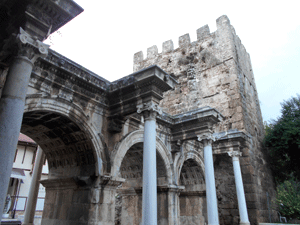 As for us, in true Rick Steves tradition, we left the bus and lugged our bags through the city walls into Kaleiçi, the old district, to the small Ninova Pension. Mert led us on an orientation walk, with some history of the area and a little tour of the major points of interest. The main entrance into Kaleiçi is through Hadrianus Gate, built by the eponymous Roman emperor and still an impressive structure. I was intrigued by Kesik Minare (Broken Minaret Mosque), which started life as a Roman temple, then became a Christian church, then a mosque, then I think it was a Christian church again, and then back to a mosque before — I think — it burnt down. I may be confused on the chronology; my head was spinning.
As for us, in true Rick Steves tradition, we left the bus and lugged our bags through the city walls into Kaleiçi, the old district, to the small Ninova Pension. Mert led us on an orientation walk, with some history of the area and a little tour of the major points of interest. The main entrance into Kaleiçi is through Hadrianus Gate, built by the eponymous Roman emperor and still an impressive structure. I was intrigued by Kesik Minare (Broken Minaret Mosque), which started life as a Roman temple, then became a Christian church, then a mosque, then I think it was a Christian church again, and then back to a mosque before — I think — it burnt down. I may be confused on the chronology; my head was spinning.
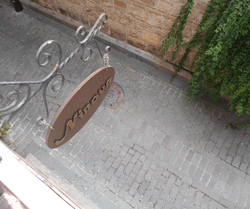 Our pensione was quiet and charming, with an outdoor patio where we ate breakfast and relaxed between outings by watching the resident cat and her kittens in play. Strolling around the peaceful quarter was only a bit confusing as the gate, clock tower, and fluted minaret of the Yivli Minare served as useful landmarks; besides, it was only a short walk to the coastline and a fabulous view of the Mediterranean with the mountains in the distance. We had a group dinner at a local Meyhane the first evening, followed by a day of R&R, so to speak, before delving into archeology. There were other tourists lurking about, but nothing felt crowded or busy; perhaps most visitors were busy shopping in one of the huge malls elsewhere in the city.
Our pensione was quiet and charming, with an outdoor patio where we ate breakfast and relaxed between outings by watching the resident cat and her kittens in play. Strolling around the peaceful quarter was only a bit confusing as the gate, clock tower, and fluted minaret of the Yivli Minare served as useful landmarks; besides, it was only a short walk to the coastline and a fabulous view of the Mediterranean with the mountains in the distance. We had a group dinner at a local Meyhane the first evening, followed by a day of R&R, so to speak, before delving into archeology. There were other tourists lurking about, but nothing felt crowded or busy; perhaps most visitors were busy shopping in one of the huge malls elsewhere in the city.
A visit to the Antalya Museum, located just outside the Old City, was an optional excursion, but well worth it. One of the largest and most important museums in Turkey, the collection illuminates the history of the Mediterranean and Pamphylia regions of Anatolia with thousands of exhibits from local archeological excavations, including an absolutely stunning display of statues from Perge. Other rooms are devoted to tiles, carpets, costumes, and other items from the Ottoman period, with dioramas of rooms from typical Anatolian houses. Probably the most famous piece in the museum is the 2nd century Roman Imperial sculpture of Herakles, the head and torso of which were returned to Turkey in 2011 from the Museum of Fine Arts Boston. The mostly complete sculpture is beautifully displayed in the Hall of the Sarcophagi, along with an impressive collection of Labors-of-Hercules- and other classical themed burial sculptures.
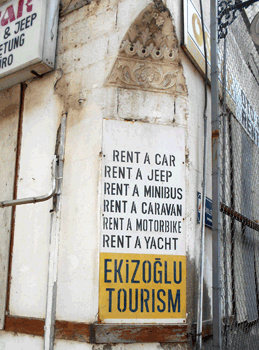 Leaving the museum, a few of us headed down to the beach, dotted with rows of beach umbrella-shaded cabana chairs. The shoreline was pretty much deserted, it being autumn and not exactly beach weather, and the concessions were all closed (although one guy did walk down and ask us for payment to use the facilities). The beach itself was pebbles, not sand — and when they say “pebbles” they mean really big ones, not at all comfortable to walk on for a chance to dip ones toes into the Mediterranean. But we did, and then trudged back up the hill. Running into more members of our group, as happened often, we all decided to take a tram ride back toward Hadrian’s Gate for a late lunch at Leman. This restaurant was named, evidently, for the Turkish equivalent of Mad magazine, with many illustrations and issues on display; I can’t imagine what food an American Mad-themed eatery would provide; Leman had excellent beer and very good pizza.
Leaving the museum, a few of us headed down to the beach, dotted with rows of beach umbrella-shaded cabana chairs. The shoreline was pretty much deserted, it being autumn and not exactly beach weather, and the concessions were all closed (although one guy did walk down and ask us for payment to use the facilities). The beach itself was pebbles, not sand — and when they say “pebbles” they mean really big ones, not at all comfortable to walk on for a chance to dip ones toes into the Mediterranean. But we did, and then trudged back up the hill. Running into more members of our group, as happened often, we all decided to take a tram ride back toward Hadrian’s Gate for a late lunch at Leman. This restaurant was named, evidently, for the Turkish equivalent of Mad magazine, with many illustrations and issues on display; I can’t imagine what food an American Mad-themed eatery would provide; Leman had excellent beer and very good pizza.
In Antalya we had a chance to visit a hamam, the ultimate Turkish cultural experience. Rafat escorted us to the Demirhan Hamam minibus, which picked us up outside the Old City wall, and joined our gentlemen for their Turkish bath process. (He was also instructed to inform the ladies’ attendants to treat us delicate foreign flowers gently.) After exchanging our clothes for a peştemal in a private cubicle, we proceeded to the hot room (hararet) with our loufah mitts and sauna-tized ourselves until called out to be sudsed up and scrubbed. Then another interval before the massage, after which we could relax and recuperate before dressing and heading out. (Mert advised us to keep our loufahs, as they can be reused and can cost a pretty penny back home.) There is a charming description and explanation of the hamam experience and protocols on this WITT Magazine web site (along with a lot of other useful information especially on Istanbul).
Return to Turkey 2014 Index

